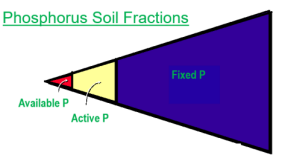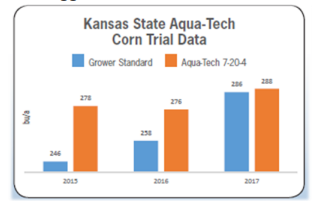The "Focus on P"
November 21, 2024

The importance of Phosphorus
There may be as much as 500 years’ worth of phosphorus (P) in the soil. The problem is, it is not available4 . Available soil P is limited because of its tendency to react with other minerals. In soil, P is found in 3 pools:
1. Available in solution (Solution P) – consists of orthophosphate and organic phosphorus. This is the P in the soil that plants are able to absorb.
2. Readily available (Active P) – soil particles release P to replace what is absorbed from Solution P.
3. Unavailable (Fixed P) – This portion of P is insoluble and resistant to movement into Solution P. Most of the P in the soil is in this form1.
Because P has a high potential to react with other minerals and move to Fixed P, broadcast fertilization is very ineffective. As little as 10% is available the first year after application3. Just as concerning, as time passes after fertilization, P is less available5. This is very concerning considering crop demand for P increases at fruit set (grain, beans, bolls, etc). Crop demand for mid-season P and potential for P to “fix” over time suggest a need for in-season P fertilization. Since 1946 foliar feeding NACHURS has been a BMP.
We recommend 1-2 g/acre of Triple Option® or imPulse®; adding 1 qt of FinishLine® or micronutrients improve performance even more. Research agrees foliar P may improve yield and P use efficiency2. Fertigation with NACHURS Aqua-Tech 7-20-4® is another option. When applied through irrigation, results have been very impressive.
In-season P fertilization works in two ways:
1. Nutrients become available to transport to developing fruit.
2. Plant health is stimulated and nutrient exchange in the root zone improves.
As always, if you have any questions, please get in touch with me or your local NACHURS Representative.
Wayne Becker, NACHURS District Sales Manager – Texas
Busman, L., J. Lamb, G. Randall, G. Rehm & M. Schmitt, 2002. The nature of phosphorus in soils. www.extension. umn.edu/distribution/cropsystems/DC6795.html.
Kefyalew Girma, K. L. Martin, K. W. Freeman, J. Mosali, R. K. Teal, William. R. Raun, S. M. Moges & D. B. Arnall (2007) Determination of Optimum Rate and Growth Stage for Foliar‐Applied Phosphorus in Corn, Communications in Soil Science and Plant Analysis, 38:9- 10, 1137-1154, DOI: 10.1080/00103620701328016
Ruiz Diaz, D.A., D.B. Mengel, and K.L. Martin. 2011. Phosphorus Facts: Soil, Plant, and Fertilizer. Kansas State University Agricultural Experiment Station and Cooperative Extension Service. C-665.
Sander, D.H., E.J. Penas. (1982). G82-601 Using Phosphorus Fertilizer Effectively. Ext. Bull. G601. Soil Resource Management. Univ. Nebraska-Lincoln Ext., Univ. of Nebraska Lincoln, Lincoln, NE.
Sharpley, A.N., U. Singh, G. Uehara, and J. Kimble. 1989. Modeling soil and plant phosphorus dynamics in calcareous and highly weathered soils. Soil Sci. Soc. Am. J. 53:153-158.




We are at the point in the year where things are slowing down around the farm and it is time to reflect on the season to remind ourselves what we learned. Over the last couple of weeks, the District Sales Managers and I have spent some time reflecting on what worked well in the field and the challenges we faced too. Here are the top 5 things we learned from 2024 growing season: #1 Split applying Nitrogen and Sulfur is a practice that should be embraced on a yearly basis when growing corn. Do you remember how the planting season started and what happened in the first 60 days after the planters started rolling? Our field conditions started out dry with some areas of the corn belt showing up on the drought map. Then mother nature blessed us with rain that never stopped in some areas making it difficult to finish planting. Growers that had split applied their Nitrogen and Sulfur were able to avoid nutrient loss from the rain but also apply the nutrients when the crop needed it most. In the end yield was better on split applied nitrogen fields compared to fields that had all the N applied in the fall or spring before planting. #2 For the past 2 seasons in the North region, we have seen the benefits of adding NACHURS Humi-Flex FA to the in-furrow starter fertilizer. NACHURS Humi-Flex FA is our fulvic acid and it is becoming a valuable component in our starter fertilizer for many reasons. We are using it to chelate the nutrients in the starter fertilizer especially phosphorus. Humi-Flex FA also buffers the soil pH to neutral in that nutrient band keeping nutrients available in fields that have less then optimal pH for crop growth. Finally, we use Humi-Flex FA to create a healthy soil microbiome that leads to more root mass and nutrient uptake. #3 Nutrient uptake charts for corn and soybeans have been a great tool for our team to help our customers visualize the crops nutrient needs based on timing during the growing season.











